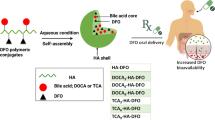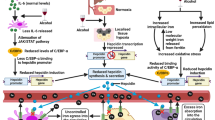Abstract
Iron overload is present in several cases of double heterozygous sickle-cell/beta-thalassemia (HbS/β-thal). Deferasirox is an orally administered iron chelator which is effective on iron overloaded patients with transfusion-dependent anemia. The aim of this study was to investigate the efficacy and safety of deferasirox on HbS/β-thal patients with iron overload. We evaluated 31 adult patients with HbS/β-thal (14M/17F; median age 41 years) who had serum ferritin levels >1,000 ng/mL and who were sporadically transfused. Total iron burden was monitored by measuring serum ferritin levels before and monthly after starting deferasirox, while liver iron concentration and cardiac iron burden were measured by magnetic resonance imaging (MRI) T2 and T2* parameters at baseline and 12 months after deferasirox treatment. Deferasirox managed to reduce the mean serum ferritin levels after 12 months of treatment from 1,989 ± 923 to 1,008 ± 776 ng/mL (P < 0.001). This reduction was accompanied by a significant improvement on MRI T2* of the liver (from 3.9 ± 3.2 to 5.8 ± 3.1 ms; P < 0.01) and by a comparable improvement of biochemical parameters of liver function. Mild nausea and diarrhea of grade 1/2 were reported in 25% of patients within the first month of treatment, but did not re-occur. These data indicate that deferasirox provided effective control of iron levels (mainly of the liver) in minimally transfused patients with HbS/β-thal, without significant adverse events, at similar doses to those studied widely for the treatment of patients with thalassemia syndromes.

Similar content being viewed by others
References
Charache S, Terrin ML, Moore RD, Dover GJ, Barton FB, Eckert SV, McMahon RP, Bonds DR (1995) Effect of hydroxyurea on the frequency of painful crises in sickle cell anemia. Investigators of the Multicenter Study of Hydroxyurea in sickle cell anemia. N Engl J Med 332:1317–1322
Steinberg MH, Barton F, Castro O, Pegelow CH, Ballas SK, Kutlar A, Orringer E, Bellevue R, Olivieri N, Eckman J, Varma M, Ramirez G, Adler B, Smith W, Carlos T, Ataga K, DeCastro L, Bigelow C, Saunthararajah Y, Telfer M, Vichinsky E, Claster S, Shurin S, Bridges K, Waclawiw M, Bonds D, Terrin M (2003) Effect of hydroxyurea on mortality and morbidity in adult sickle cell anemia: risks and benefits up to 9 years of treatment. JAMA 289:1645–1651
Voskaridou E, Christoulas D, Bilalis A, Plata E, Varvagiannis K, Stamatopoulos G, Sinopoulou K, Balassopoulou A, Loukopoulos D, Terpos E (2010) The effect of prolonged administration of hydroxyurea on morbidity and mortality in adult patients with sickle-cell syndromes: results of a 17-year, single center trial (LaSHS). Blood 115(12):2354–2363
Wanko SO, Telen MJ (2005) Transfusion management in sickle cell disease. Hematol Oncol Clin North Am 19:803–826
Adams RJ, Mckie VC, Hsu L, Files B, Vichinsky E, Pegelow C, Abboud M, Gallagher D, Kutlar A, Nichols FT, Bonds DR, Brambilla D (1998) Prevention of a first stroke by transfusions in children with sickle cell anemia and abnormal results on transcranial Doppler ultrasonography. N Engl J Med 339:5–11
Platt OS, Brambilla DJ, Rosse WF, Milner PF, Castro O, Steinberg MH, Klug PP (1994) Mortality in sickle cell disease. Life expectancy and risk factors for early death. N Engl J Med 330:1639–1644
Angelucci E, Barosi G, Camaschella C, Cappellini MD, Cazzola M, Galanello R, Marchetti M, Piga A, Tura S (2008) Italian Society of Hematology practice guidelines for the management of iron overload in thalassemia major and related disorders. Haematologica 93:741–752
Voskaridou E, Plata E, Douskou M, Papadakis M, Delaki EE, Christoulas D, Terpos E (2010) Treatment with deferasirox (Exjade®) effectively decreases iron burden in patients with thalassaemia intermedia: results of a pilot study. Br J Haematol 148:332–334
Cappellini MD, Porter J, El-Beshlawy A, Li CK, Seymour JF, Elalfy M, Gattermann N, Giraudier S, Lee JW, Chan LL, Lin KH, Rose C, Taher A, Thein SL, Viprakasit V, Habr D, Domokos G, Roubert B, Kattamis A; on behalf of the EPIC study investigators (2010) Tailoring iron chelation by iron intake and serum ferritin: prospective EPIC study of deferasirox in 1744 patients with transfusion-dependent anemias. Haematologica 95(4):557–566
Vichinsky E, Onyekwere O, Porter J, Swerdlow P, Eckman J, Lane P, Files B, Hassell K, Kelly P, Wilson F, Bernaudin F, Forni GL, Okpala I, Ressayre-Djaffer C, Alberti D, Holland J, Marks P, Fung E, Fischer R, Mueller BU, Coates T, Deferasirox in Sickle Cell Investigators (2007) A randomised comparison of deferasirox versus deferoxamine for the treatment of transfusional iron overload in sickle cell disease. Br J Haematol 136:501–508
Voskaridou E, Douskou M, Terpos E, Papassotiriou I, Stamoulakatou A, Ourailidis A, Loutradi A, Loukopoulos D (2004) Magnetic resonance imaging in the evaluation of iron overload in patients with beta thalassaemia and sickle cell disease. Br J Haematol 126:736–742
Wood JC, Enriquez C, Ghugre N, Tyzka JM, Carson S, Nelson MD, Coates TD (2005) MRI R2 and R2* mapping accurately estimates hepatic iron concentration in transfusion-dependent thalassemia and sickle cell disease patients. Blood 106:1460–1465
Terpos E, Katodritou E, Tsiftsakis E, Kastritis E, Christoulas D, Pouli A, Michalis E, Verrou E, Anargyrou K, Tsionos K, Dimopoulos MA, Zervas K, Greek Myeloma Study Group (2009) Cystatin-C is an independent prognostic factor for survival in multiple myeloma and is reduced by bortezomib administration. Haematologica 94:372–379
Porter JB, Huehns ER (1987) Transfusion and exchange transfusions in sickle cell anemias, with particular reference to iron metabolism. Acta Haematol 78:198–205
Charache S (1981) Treatment of sickle cell anemia. Annu Rev Med 32:195–206
Pakbaz Z, Fischer R, Treadwell M, Yamashita R, Fung EB, Calvelli L, Quirolo K, Foote D, Harmatz P, Vichinsky EP (2005) A simple model to assess and improve adherence to iron chelation therapy with deferoxamine in patients with thalassemia. Ann NY Acad Sci 1054:486–491
Cohen AR, Galanello R, Piga A, De Sanctis V, Tricta F (2003) Safety and effectiveness of long-term therapy with the oral iron chelator deferiprone. Blood 102:1583–1587
Vichinsky E, Pakbaz Z, Onyekwere O, Porter J, Swerdlow P, Coates T, Lane P, Files B, Mueller BU, Coïc L, Forni GL, Fischer R, Marks P, Rofail D, Abetz L, Baladi JF (2008) Patient-reported outcomes of deferasirox (Exjade, ICL670) versus deferoxamine in sickle cell disease patients with transfusional hemosiderosis. Substudy of a randomized open-label phase II trial. Acta Haematol 119:133–141
Voskaridou E, Christoulas D, Papatheodorou A, Plata E, Xirakia C, Tsaftaridis P, Boutsikas G, Terpos E (2009) Angiogenic molecules and inflammatory cytokines in patients with thalassemia major and double heterozygous HbS/beta-thalassemia; the impact of deferasirox. Blood 114:797 [abstract 2018]
Voskaridou E, Douskou M, Terpos E, Stamoulakatou A, Meletis J, Ourailidis A, Papassotiriou I, Loukopoulos D (2005) Deferiprone as an oral iron chelator in sickle cell disease. Ann Hematol 84:434–440
Banarjee S, Owen C, Chopra S (2001) Sickle cell hepatopathy. Hepatology 33:1021–1028
Inati A, Musallam KM, Wood JC, Sheikh-Taha M, Daou L, Taher AT (2010) Absence of cardiac siderosis by MRI T2* despite transfusion burden, hepatic and serum iron overload in Lebanese patients with sickle cell disease. Eur J Haematol 83(6):565–571
Coll E, Botey A, Alvarez L, Poch E, Quintó L, Saurina A, Vera M, Piera C, Darnell A (2000) Serum cystatin C as a new marker for noninvasive estimation of glomerular filtration rate and as a marker for early renal impairment. Am J Kidney Dis 36:29–34
Voskaridou E, Terpos E, Michail S, Hantzi E, Anagnostopoulos A, Margeli A, Simirloglou D, Loukopoulos D, Papassotiriou I (2006) Early markers of renal dysfunction in patients with sickle cell/beta-thalassemia. Kidney Int 69:2037–2042
Author information
Authors and Affiliations
Corresponding author
Rights and permissions
About this article
Cite this article
Voskaridou, E., Plata, E., Douskou, M. et al. Deferasirox effectively decreases iron burden in patients with double heterozygous HbS/β-thalassemia. Ann Hematol 90, 11–15 (2011). https://doi.org/10.1007/s00277-010-1029-7
Received:
Accepted:
Published:
Issue Date:
DOI: https://doi.org/10.1007/s00277-010-1029-7




